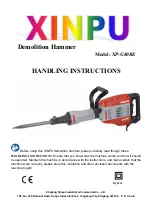
6
Mounting of table extension
Mount the table extension (I) either
left or right of the machine table.
Unfold the support legs and adjust
them in height.
Mounting of rip fence
Mount the rip fence (L) to the
machine table and adjust it with the
help of the two scales.
5.3 Dust connection
Before initial operation, the machine
must be connected to a dust
extractor.
Attach the connecting hose (G).
A 31mm inside diameter dust
collection hose can be connected.
5.4 Mains connection
Mains connection and any
extension cords used must comply
with applicable regulations.
The mains voltage and frequency
must comply with the information
on the machine licence plate.
The mains connection must have a
10A surge-proof fuse.
Only use connection cables marked
H07RN-F
Connections and repairs to the
electrical equipment may only be
carried out by qualified electricians.
5.5 Starting operation
You can start the machine with the
green on button (E). The red button
on the main switch stops the
machine.
6. Machine operation
Correct working position:
In front of the machine standing out
of the line of cutting (danger zone).
Work piece handling:
Hands placed flat on the work piece
outside the cutting area.
Feed the work piece towards the
saw blade in the direction of the
saw line. Push the work piece
steadily forward; complete the cut
as a single movement.
Support long and wide work pieces
with helping roller stands.
Operating hints:
Always observe the safety
instructions and adhere to the
current regulations.
Ensure that the saw blade
protective cover is in the correct
position before you start sawing.
The cutting blade must first reach
the maximum rpm before cutting
may begin.
Attention:
The condition of the blade should
be checked before each machining
process.
Work only with a sharp and flawless
sawblade.
Never use a sawblade rated with a
blade speed lower than the
machine.
Use a suitable wedge to prevent
round timber from turning under the
pressure of the cut
Use suitable table extensions and
supporting aids for difficult to
handle work pieces.
Always hold and guide the work
pieces safely during machining.
Do not perform any operation
freehand.
Do not perform any grooving,
tenoning or splitting operations on
this machine.
When ripping narrow work pieces
(width less than 120mm) use a
push-stick (Fig 2) or push-wood.
Fig 2
Make sure that small cut off work
pieces will not be caught and
thrown away by the rising saw
blade teeth.
Remove cut and jammed work
pieces only when motor is turned off
and the machine is at a complete
standstill.
Pay particular attention on reducing
the risk of kickback.
The supplied raving knife and saw
blade protective cover must always
be used.
Inspect for correct adjustments.
For the authorized use of the
machine observe the appendix A
“safe operation“
(on the last pages of this
operating manual)
A.1.: Ripping
A.2.: Ripping of narrow stock
A.3.: Crosscutting on rip fence
A.4.: Bevel cutting
A.5.: Mitre cutting
A.6.: Ripping of big board
7. Setup and adjustments
General note:
Setup and adjustment work may
only be carried out after the
machine is protected against
accidental starting by pulling the
mains plug.
7.1 Changing sawblade
The sawblade has to meet the
technical specification.
Use only sawblades according to
EN 847-1
Check sawblade for flaws (cracks,
broken teeth, bending) before
installation. Do not use faulty
sawblades.
The sawblade teeth must point in
cutting direction (down)
Always wear suitable gloves when
handling sawblades.
WARNING:
When installing or changing saw
blade, always disconnect saw from
power source, unplug!
Remove the saw guard (A) and the
table insert (N).
Remove the 2screws (T), slide the
cover (U) up and open it.
Using the wrenches provided (O; P,
Fig 3), loosen the arbor nut(R) while
stopping the flange(S) against
rotation.
Содержание JTS-8
Страница 19: ...21 Appendix A A1 A2 A3 A4 A5 A6 ...





































